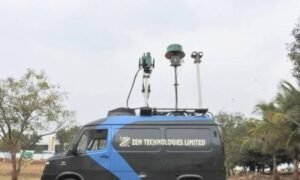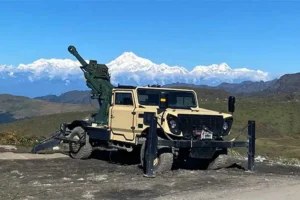Source : The Eurasian Times
 |
| Boeing KC-135 Stratotanker refueling an American F-15 Eagle- Wikipedia |
The last few years have seen an uptick in using Unmanned Aerial Systems (UAS) on battlefields. First, the Armenia-Azerbaijan war and then the Russia-Ukraine war has established that drones will dominate future conflicts.
Air operations have traditionally relied on powerful crewed warplanes to accomplish critical combat and non-combat duties in airpower-reliant militaries like the United States.
However, as adversaries develop abilities to detect and engage these aircraft from greater ranges, advanced UAVs come into the picture, which are unmanned and not as expensive as fighter jets.
With a significant role envisioned for drones to be deployed by the military, there is a need for enhanced range and better efficiency. The Defense Advanced Research Projects Agency (DARPA) wants US Air Force aerial tankers to take refueling to the next level by using laser beams to enhance the range of unmanned aircraft systems.
DARPA has issued a call for information from industry stakeholders on the viability of deploying modified manned tanker planes to wirelessly deliver power to unmanned aerial vehicles through laser beams, which may be a potential game-changer for the US military.
The Airborne Energy Well concept was first proposed by DARPA’s Tactical Technology Office in a Request for Information (RFI) seeking to investigate wireless energy transmission for drones earlier this week. The agency is looking for solutions that may be installed onto existing refueling planes like the KC-46 Pegasus and KC-135 Stratotanker.
“Responses to this RFI will be used to inform and explore future programs that advance the ability of airborne assets to dynamically move energy across a network of aircraft equipped with energy beaming and receiving technologies,” according to DARPA.
The wireless movement of energy (heat or electricity) from one location to another using laser light is known as laser power beaming. It can be pointed at any area and provides power 24 hours a day. Power can be transmitted by optical fibers, air, or space.
“While wireless energy transfer technology has begun adoption in small applications in the commercial space, the capability within the wide range of military applications has only been marginally explored,” DARPA said. “By leveraging power beaming, this same tanker could also recharge a network of UAS wirelessly,” it added.
Laser Energy For Refueling The UAS
A laser is a beam of concentrated electromagnetic energy that can be used to refuel an unmanned aerial system to enhance its range and the time it can stay in the air. DARPA stated that it intends to build on existing wireless energy transfer research and development for unmanned aircraft systems.
“These UAS could be designed to receive directed energy to reduce the weight of their organic energy storage,” DARPA said. “This energy transfer ability may extend range and operations, with a similar impact that air-to-air refueling has had on DOD operations.”
The agency aims to investigate tactical mobile energy production and distribution for future fleets of UAS, similar to typical air-to-air refueling operations that enhance tactical aircraft operational range and endurance but without requiring physical links.
According to the agency, one feasible technique would be an underwing power beaming pod capable of producing a practically continuous laser output of roughly 100kW. As the Air Force attempts to take other parts of remotely piloted air combat vehicles airborne, the possibility of enhancing UAS range through directed energy has emerged as a significant concept.
However, this would require a thermal control device that integrates the laser into the tanker. The technology would also be intended to enable beam formation and steering of laser energy “covering a nearly hemispherical field of regard,” ensuring that the energy goes where it’s needed.
There is also a need to learn more about generating power aboard the tanker and utilizing current or new equipment. The drones’ organic energy storage would be reduced, allowing them to carry more weaponry or sensors, for example, or benefit from increased endurance without having to land.
“The point for DARPA is to acquire that cutting technology that requires many risks. So, DARPA is doing what it is mandated to do. They are starting with drones because they would be the lightest and most fuel-efficient. So, they start with the drones, and eventually, they may be able to do it with bigger aircraft and fighters. America has the economic and scientific power to do it, and once they can demonstrate it, they can bring the price down to an acceptable level. This is what they did with Gallium Arsenide and Gallium Nitride. We don’t have an idea about the gestation period. Still, it is good they are pushing boundaries”, said Abhijit Iyer Mitra, a military expert and Senior Fellow at the New Delhi-based Institute of Peace and Conflict Studies.
Earlier, a company called PowerLight demonstrated in 2019 that its power-beaming system could transmit 400 watts of power to run various lights, laptops, and a coffeemaker. It later followed up in 2020 with a demonstration of a drone-friendly lightweight power receive, Geek Wire had noted.
In October 2021, Ericsson and PowerLight Technologies demonstrated optical beaming, a technology for transmitting electricity to a portable 5G base station using the laser. The demonstration employed a transmitter and a receiver, which can even be hundreds or thousands of meters apart.
However, DARPA is looking to go over and beyond the current commercial space to ensure laser beaming is suitable for use by the military.
Future Drone Warfare
Unlike fighter jets, which require frequent refueling and cause crew fatigue, drones can remain in the air for up to 24 hours while conducting surveillance, testing air defenses, or waiting for a target.
According to Air Force Secretary Frank Kendall, the Air Force is completely embracing the concept of partnering unmanned air combat systems with piloted aircraft, such as the sixth-generation fighter and the B-21 Raider bomber, as a cost-effective approach to increasing fleet size.
General Kenneth Wilsbach, Commander of the Pacific Air Forces, argues that it would be considerably more appropriate to deploy “attritable” unmanned aircraft against China rather than high-end stealth fighter jets such as F-35s or F-22s.
The best option for the US Air Force in the event of a conflict with China, according to the top military official, would be to amass attritable systems — such as decoys or inhabited UAVs — to exhaust the Chinese defense because they would have more targets to fight against and no idea what that airborne asset is. China has a very sophisticated Anti Access/Area Denial system in place.
The Armed services want advanced autonomous aircraft that can be used repeatedly and, ideally, never be shot down. According to European Security and Defence, increasing the number of combat aircraft in the fleet makes it easier to accept losses while maintaining combat power.
The US is also significantly enhancing the swarm drone technology to tackle future challenges. A system to refuel these drones without making them land would boost the capability of the US Air Force, especially in a conflict in China that would require the US military to go close to the enemy lines.







